Participating in “The 5th Journalism Award on Cultural Development and Building an Elegant and Civilized Hanoi People – 2022”, authors Do Thi Van Que, Do Tran Quan, Nguyen Tuan Dung and Ta Minh come from the topic of Capital Security, the People’s Public Security newspaper excellently won the A prize with the work “Digitalization to revive heritage and bring back the history” with 4 consecutive series. Portal of Hanoi Department of Culture and Sports would like to introduce the above work to public!
With a 3D simulation of the architectural form of the palace of the Ly Dynasty, the Imperial Citadel Research Institute is considered the first state unit to apply digital technology to partially reconstruct the Thang Long Imperial Citadel heritage from research and a system of relics and artifacts discovered (in the excavation pits of the site 18 Hoang Dieu). When these simulations were published, besides the positive reactions from the public, there were still many concerns. But if always concerned and worried without opening the way step by step, how can there be a wide avenue for the next step (?!).
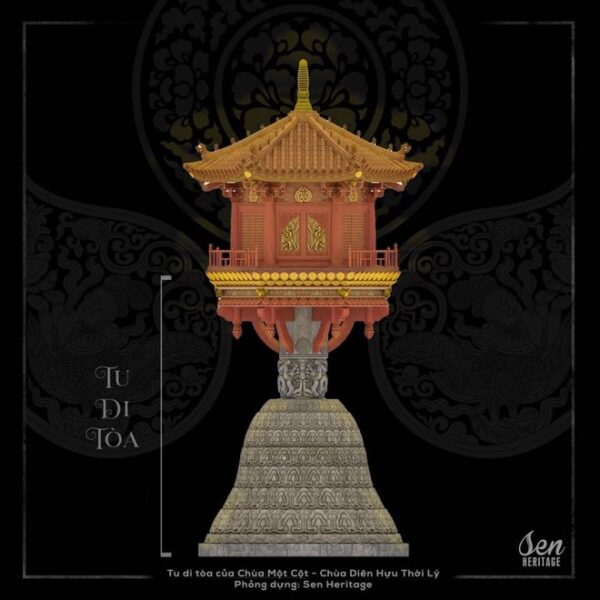
Pioneering experiments
In fact, many years ago, there were a few projects that simulated and simulated heritage in Hanoi using 3D technology. However, this is only the work of a group of heritage lovers, and technology enthusiasts, and of course paying for this passion is from their personal pocket.
In 2020, based on the ruins of the stone column of Dam Pagoda and the stele Sung Thien Dien Linh (engraved in 1121), the SEN Heritage team tried to come up with a plan to recreate the lotus architecture with 1 column and 6 edges of the Ly dynasty (single pillar and 6 edges of lotus tower – History of Viet Nam) at Dien Huu Pagoda (One Pillar Pagoda). This temple is a symbol of the culture of Thang Long – Hanoi, but the current architecture was restored in 1955, inheriting the style of the Nguyen Dynasty. Therefore, this project aims to re-establish the ground of the Ly Dynasty, the architecture of the Ly Dynasty, the art style of the Ly Dynasty from archaeological artifacts and inscriptions, in order to convey the cultural quintessence of the ancient Dai Viet to the society.
If, Dien Huu Pagoda is a simulation of a microcosm in the Buddhist worldview with the One Pillar tower (the lotus tower is located in the center of the multi-dimensional concentric mandala), then VR technology products are an effort to realize the planimetric structure and architectural art of the Ly Dynasty so that viewers can “step into history”. Although this is just “virtual reality”, architectures and architectural proportions have been processed based on specific data, aiming at reproducibility options and serving the dissemination, teaching, preservation and promotion of Dai Viet culture of the Ly dynasty to the society.
After 3 years, the SEN Heritage team has launched the VR3D Dien Huu product. The members of SEN Heritage expressed their wish to one day be able to walk in the historic Dien Huu temple. Vietnamese people of the 21st century can “step into history”, “walk in history”, can walk in the splendid space of royal Buddhist art, can “put hands to touch artifacts of thousand years”, to understand the talented hand of his father shown through every stroke and engraving on the architecture. And not far away, from this “virtual reality” work, it is entirely possible to recreate the Dien Huu pagoda of the peak architectural art of the Ly dynasty.
After the initial success of the reconstruction of the architecture of Dien Huu Pagoda in the Ly Dynasty in 2021, SEN Heritage continues to publish the image of the newborn Shakyamuni Buddha statue sitting on a stone pillar carved with lotus bud and dragon scroll in the Ly Dynasty. It is assumed that the statue with the lotus throne could have been placed in the dragon pond in Phat Tich pagoda (Bac Ninh province) more than 9 centuries ago. The simulation work is carried out based on the study of archaeological artifacts such as Bach Thao stone pillar, Phat Tich pagoda stone foot, and lotus flower top at Bac Ninh Museum… Among them, Bach Thao stone pillar, is on display at the National Museum of History. The stone pillar at Phat Tich Pagoda has been lost, but there are still photos taken from the French period. Both of these artifacts have lost the statue, broken legs and tops. The simulation work includes products such as: The stonework, 2D drawing, 3D drawing of the stone pillar, the AR version of the newborn Shakyamuni Buddha, the 3D-VR3D-VR virtual reality simulation of the newborn Shakyamuni Buddha based on the art style of the Ly Dynasty.
Combining existing documents, the SEN Heritage team restored the entire structure of the newborn Shakyamuni court during the Ly Dynasty with a structure consisting of 3 parts. Part 1 is a pillar consisting of a 6-sided stone slab with 3 levels; part 2 is the body of the pillar including the project of Cuu Son Bat Hai, Song Long Hien Chau and the lotus tower; Part 3 is the newborn Shakyamuni statue. The newborn Shakyamuni is the center of the Buddha bathing ritual in Buddhist culture. Since the Ly Dynasty, the belief of worshiping Shakyamuni’s birth is associated with Buddha’s birthday (April 8 of the lunar calendar).
The SEN Heritage research team at that time expressed their wish that the restoration of the relics of the Ly dynasty’s newborn Shakyamuni statue would be associated with the restoration of the Buddha bathing ritual at a national level, in the specific space of Dien Huu Pagoda, contributed to the spread of Dai Viet cultural values during the Ly Dynasty, as well as Buddhist culture.
The Hanoi 3D group amazed visitors 18 years ago (2004) when it launched the exhibition with a series of pictures that recreated the image of old Hanoi streets, Hanoi during the anti-French resistance war… associated with architectural and historical events taking place in the capital. The people working on this project said at the time that the long-term goal is to build a product that can initially be used in the cultural industry, generate post-production, edit research films, documentaries, and so on. Then become an intuitive, lively, and effective method in traditional culture teaching and development; developing a tool to promote the image of Hanoi’s capital city to the world honestly but artistically, creating a rich, quality, accessible, and friendly source of materials.
Continuing the inspiration from the project, in 2009, 3D Hanoi continued to cooperate with Ashui.com network to implement the project “Recreating French architectural heritage in Hanoi with 3D technology” with the goal of building an online museum (library) with 3D images with high accuracy from data that are technical drawings combined with current measurements, in order to create a standardized database for research, preserving existing or lost architectural works in the old quarter area in Hanoi.
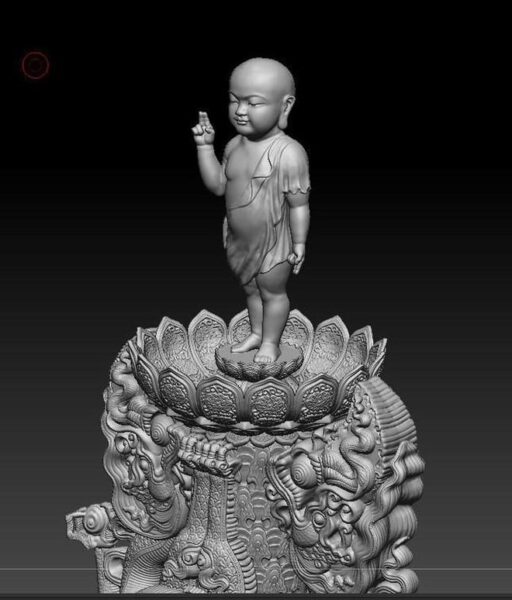
An imitation of the newborn Shakyamuni Buddha on a lotus statue during the Ly Dynasty
Vietnam has an extraordinarily rich natural and cultural heritage system, both tangible and invisible, that stretches over the S-shaped strip of land. Many heritages, in particular, have been recognized by the United Nations Educational, Scientific, and Cultural Organization (UNESCO), becoming world property. People can create many new wonderful works, challenge and conquer all boundaries, but they cannot create heritage, because heritage is the past, history, and culture – these are the riches that should be treasured, safeguarded, and preserved.
Around the world, natural and cultural heritage have become fundamental elements for positioning national identity in the modern world. Promoting responsible conservation of heritage at national, sectoral and local levels, promoting sustainable values to spark development has been done in many countries and regions. The past is the future. “DIGITIZATION OF THE HERITAGE” is the “linkage” of the past to the present. In the current period, the application of information technology is a trend and is one of the optimal solutions to store, preserve and promote the value of heritage; making the heritage shine, bringing socio-economic benefits to the country and people; bringing sustainable values to modern cities.
Virtual but real and sighs…
In 2016, from his personal social network, Nguyen Tri Quang published an image of the entire VR3D space of Tien Le communal house (Hoai Duc district, Hanoi). This lively clip allows visitors to clearly see every detail of the house. At that time, even those in the cultural heritage management industry must be surprised, because this is really an accurate projection system with full color, size, cross-section, high resolution, clearly recording every grain of the wood, bricks, and every corner of the communal house… If based on this work, deviations and distortions when repairing and restoring will be easily detected and adjusted. High-quality 3D scanning copy is also an “asset” to be kept forever before the fluctuations of time, natural disasters, fires, and wars…
Not only that, VR3D Tien Le communal house also creates an interactive scenario for viewers, just like a tour. The 3D scanning of Tien Le communal house took away from this young man 2 years of experience and 4 months of construction. Of course, the funding must come from the “family budget”. In 2016, when Nguyen Tri Quang announced this work, the clip design was like a tour allowing viewers to interact, zoom in, zoom out, measure, draw, and stamp… every detail, from the base down to each tile that makes many people “shocked”, including cultural managers.
The media at that time also asked if individuals could do it, whether museums or monuments under the management of the State could do it or not? And there were many sighs of regret: “We have not had the conditions to preserve the heritage in this way. It is very expensive and technical conditions could not allow”.
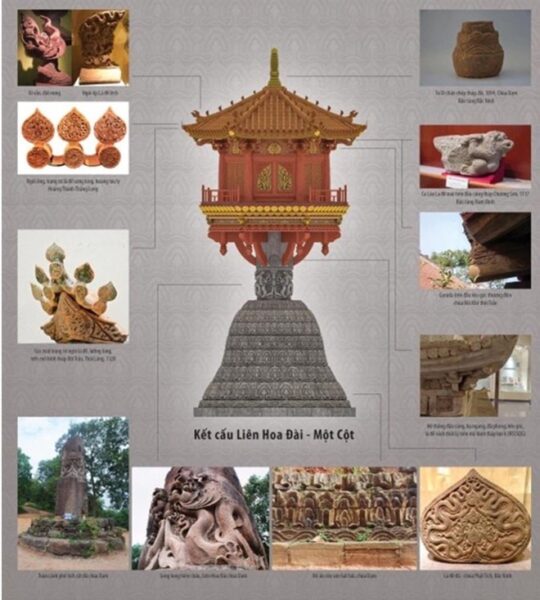
A rendering of a one-column structure from archeological documents (Image: SEN Heritage)
Digitization is a long and determined process
6 years later (2020), when the Covid-19 pandemic raged across countries and territories around the world, the social distancing for disease prevention and control made all museum and entertaining activities stopped. The trend of sightseeing, tourism… in the traditional way was forced to be interrupted. Just then, a number of State museums began to announce virtual reality exhibitions, museums, and online tours. The concept of VR3D is a technology that simulates everything realistically, displayed in a 3-D environment, viewers can fully interact, and rotate to observe right in the browser without installing any additional software. It has become familiar and commonplace.
Also in the spirit of digitization, Hoan Kiem and Dong Da districts (Hanoi) also launched the website hoakiem360.vn and dongda360.vn. Here, the application uses the user’s GPS coordinates as a platform with the following main features: Searching for tourist, service, and commercial locations displayed as a Google map or list; experience and explore places with 360-degree photo technology; hotel reservation, tour booking, reservation services and e-commerce… The application currently supports iOS, Android, Windows Phone, Web Browser platforms. With just a smartphone, visitors will directly interact and experience the landscapes, historical sites, tourist destinations, and commercial services in an intuitive and vivid way like standing right in that place.

“Digitization is becoming especially important, if still wait, it will be late. Because society develops day by day, but heritage and documents fade quickly. Just do it first, the foundation and the technique will be added later if you are determined to do it all… Digitization is a long process, it has to be done step by step, just like people give birth and raise a child. It takes a lot of attention, regular care, and growth before one person can grow up and get married”.
Mr. Pham Tuan Long (Chairman of the People’s Committee of Hoan Kiem District, Hanoi)
Talking to the Capital Security, Mr. Pham Tuan Long – Chairman of the People’s Committee of Hoan Kiem District (Hanoi) said that the purpose of the district when implementing the website: hoakiem360.vn is for visitors to get the most authentic view, You can sit at home and still experience and learn about the local historical sites, cultural heritages and scenic spots. It is also the most specific information so that visitors can find out in advance about the destination, find restaurants, accommodation facilities… Next and equally important is to want to reach out to the world through digital technology. children, helping them understand and love their cultural heritage and appreciate history. Mr. Pham Tuan Long emphasized that the website hoakiem360.vn will continue to edit, refine and update the data to become thicker and thicker, attracting a large number of people to approach and access. The above website is also self-discovered by generations of leaders of Hoan Kiem district, but there is no unified standard for districts. Because the issue of digitizing cultural heritage is becoming especially important, if still wait, it will be late. Because society develops day by day, but heritage and documents fade quickly. Just do it first, the foundation and the technique will be added later if you are determined to do it all… ” – Chairman of Hoan Kiem District People’s Committee Pham Tuan Long affirmed.
When asked what was the most challenging aspect of digitizing some documents and cultural heritages in the Hoan Kiem district, Mr. Pham Tuan Long replied, “It is the human factor!” That is, the key is in the perception, followed by the method. It is also inexpensive because it may encourage socialization without requiring a large number of devices. However, we must know the priority of what to do first and which stages to complete later. The chairman of the Hoan Kiem District People’s Committee considers digitization as a long process that must be completed step by step, quite like giving birth and raising a kid. After only a few months, the digitization of the Hoan Kiem neighborhood is now like a baby. The digitization of Hoan Kiem district is now like a baby just a few months old. It takes a lot of attention, regular care, and growth before one person can grow up and get married.
Vietnam’s cultural heritage is formed along with the flow of thousands of years of history of the nation. These are evidences of outstanding value, containing information about the past with diverse content, unique, irreplaceable, and far-reaching. However, in order to preserve, promote and spread these precious values, it is necessary to have a journey of “awakening”, “opening the way” so that cultural heritage has the opportunity to come closer to the public.
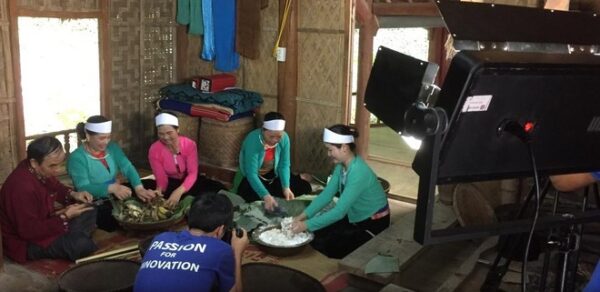
Deploying data digitization of Vietnamese ethnic groups (Photo: Vietsoftpro)
The story of an industry: It is necessary to have a primary goal in order to change priorities.
Digital transformation is an inevitable trend in the 4.0 technology era. Particularly in the field of culture, digitization is considered an important step to both do well in conservation and bring about positive changes in heritage promotion. Let’s talk with Ms. Pham Thi Lan Anh, Head of Heritage Management Department, Hanoi Department of Culture and Sports about the story of digitization and the arduous journey of making heritage “tell a story”…
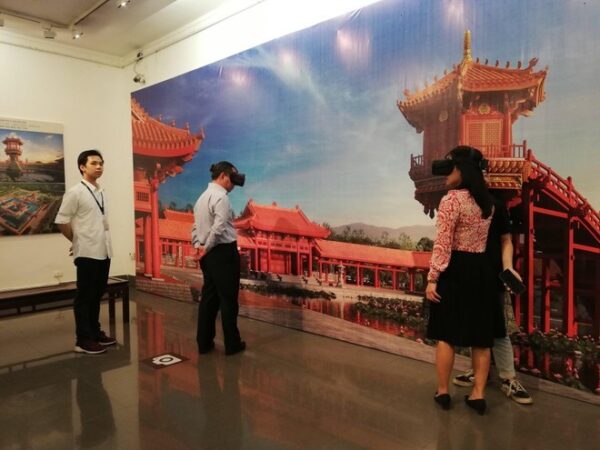
Audiences experience virtual reality technology products (Photo: SEN Heritage)
Just stop in documenting
– PV: Madam, we should understand the digitization of heritage in which way to align with the goal and nature of preserving and promoting heritage values.?

Ms. Pham Thi Lan Anh, Head of Heritage Management Department, Hanoi Department of Culture and Sports
– Ms. Pham Thi Lan Anh, Head of Heritage Management Department, Hanoi Department of Culture and Sports: Currently, there are many ways to understand digitalization in general and digitalization of cultural heritage in particular. Some people understand digitization as the pure use of technological equipment. And digitization according to world standards that other countries are implementing requires many stages, of which technology application is only the last step. But it is a fact that, even with the simplest digitization, currently in all provinces, including Hanoi, there is no basis to do this in the most basic way. Let me give you an example, the relic ranking profile is now only scanned into a PDF file, classified, grouped and stored. When you need to look up, you can print it out on paper, or you can view it on your computer or smartphone. Firstly, the above stage has not been done in many localities. Second, people consider it digitization, but in my opinion it just stops at documenting.
– Does this imply that we are in the process of digitization? How would it be if it were examined more closely??
– First, we separate tangible and intangible heritage. Documenting the group of intangible heritage has been done in the past by many methods. For example, in the field of music is recording and later video recording. In performance art, there is notation. Previously, the late Professor Tran Van Khe performed notation of Ca Tru tunes, but documenting it was not easy. This requires a degree of expertise and understanding of musical notes, and non-professionals can only do the recording. Another form of documentation is rewriting. Hát văn is being proposed to be documented by rewriting, then singing and recording, thus completing the documentation. Another way of documenting is by still images (photography) and moving (recording). Intangible heritage is just that, and not all of it is fully documented. Ca Tru, Chau Van, and Xoan singing, for example, all include dances. Or the event has costumes, props, lyrics, performances… it is impossible to visualize everything if not for recording. We used to rely on word of mouth, but we needed to document it as the foundation for digitization.
Digitization is to promote heritage value and the trend of the future.
“Vietnamese cultural heritage is formed along with the flow of thousands of years of history of the nation. Time proves the value of heritage, but time also destroys and causes heritage to be damaged or lost. Nothing lasts forever, stone is the best material, but for hundred years, it will also wear out. Brick, tile, and wood… are organic materials, so their existence is much lower. In addition to time, people, tourists, and visitors also cause damage to heritage from intentional to unintentional. Weather, climate change, changes in history, natural disasters, fires, wars, and urbanization cause villages to “change”, customs and habits gradually disappear, causing heritage to be lost or damaged, degraded, making the management and conservation of heritage difficult. Therefore, digitalization is very necessary and urgent in preserving and promoting heritage, which is the trend of the future”.
Ms. Pham Thi Lan Anh (Head of Heritage Management Department, Hanoi Department of Culture and Sports)
For physical heritage, it is easier to document because it is static. Artifacts, architectural works, relics… are photographed from different angles, with architectural drawings, art drawings, decorative patterns, detailed carvings. However, the use of images and 360-degree video recording cannot reach the world because we can see it but cannot describe the measurements, standard colors, and materials. Therefore, mere digitization would be incomplete without prior documentation. Digitizing artifacts and relics requires 90-100% of the original.
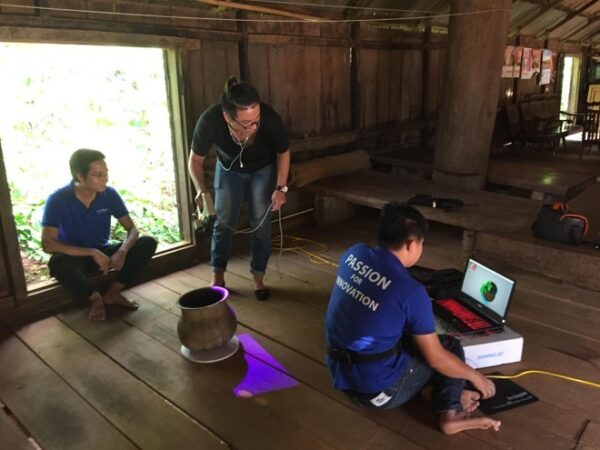
Digitization of artifacts (Photo: Vietsoftpro)
All have to wait…
– In the period 2021-2030, the program of Vietnamese cultural heritage digitization emphasizes the creation of a national database system on cultural heritage. This is simply one of several big tasks. In your opinion, how and for how long will Hanoi do this?
– This is a difficult question. I don’t know how many monuments the Ministry of Culture, Sports and Tourism has implemented to digitize, but to be honest, there is a lot of work to be done with just one relic. Meanwhile, Hanoi has up to 21 monuments and clusters of special national monuments, especially the Huong Pagoda with ten points, the cluster of Thang Long four towns and many other relics of the capital. Besides, the question of what technology and technical background will be applied by the Ministry of Culture, Sports and Tourism remains unanswered. It is not known to what extent the digital information field will be deployed here. Does digitization just stop at the level of search and management or digitize in a way to apply virtual reality? Many questions are raised that make us think of a common plan and have synchronous coordination from top to bottom. If not, the Ministry will do one type, deploy another locally, later if it cannot connect to the national database, it will be a waste of time, effort and money. At the moment, I don’t know what has been approved, how to deploy it, all have to wait…
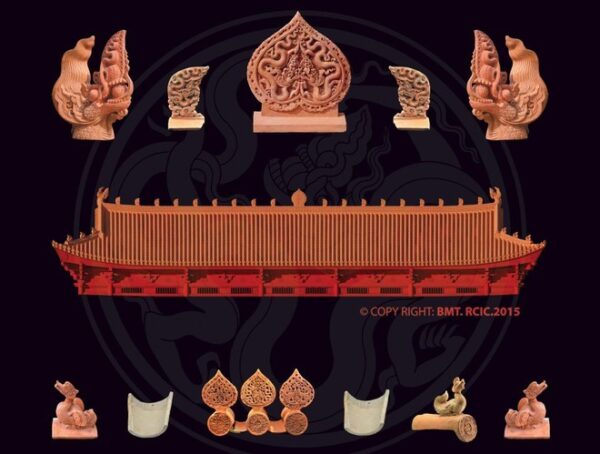
The morphology of the roof in the palace architecture of the Ly Dynasty (Photo: Citadel Research Center)
– If branching, subdividing, assigning to localities, then districts, etc., will the establishment have enough capacity to deploy heritage digitization, madam??
– From budget estimations to capacity factors, definitely not. I’ve been around the world, observing the activities of the creative city network and realizing that we have total access to their advanced technology, but we couldn’t reach their level of information technology, and we are State management, so we can’t get project funds. First, digitization is not done to put away, but to apply technology to preserve and promote heritage values. Second, we want a lot but can only do little due to our capacity and budget. Therefore, it is imperative to prioritize the digitization of valuable heritage, which must be preserved, followed by especially precious heritage with favorable conditions for exploitation. Third, not only stop digitization, along with that, there is a need for planning, technology application, investment and exploitation to develop tourism and cultural industry. Fourth, it is not possible to digitize all national cultural heritage at once, so it is advisable to deploy according to resources, where there is no experience, ask for advice and accompany many departments, departments and branches to create synchronism, consistency, high efficiency.
– Thank you very much for the discussion!
Assoc. Prof. Dr. Bui Hoai Son (Standing Member of the National Assembly’s Committee for Culture and Education): Digitization of heritage helps Vietnamese people gain more understanding and confidence in the country’s culture.

Currently, there are many agencies, organizations and individuals that digitize data in different formats. This proves that everyone is aware of the importance of digitizing stories and preserving documents. This comes from the encouragement of the Government and the urgent needs of businesses and individuals. There is a story, if digitizing too many formats without a common base, it will be like gems lying everywhere, not forming blocks to shine. There is a need for consensus in creating a common base, big data for digitizing cultural heritage documents.
When society has a great need, if we do not meet it, we will fall behind, that is a clear fact. The process of digitization, creating a network gives us the power to analyze, store, preserve and develop cultural heritage. Cultural heritage is always changing over time, cultural differences create attraction. Digitization helps us to see through cultural and regional differences, and understand more about diversity, that is the power of technology, the power of digitization. However, we also face many difficulties. The first difficulty is the awareness, sometimes incomplete from the culture makers themselves, leading to the passive implementation. They have not yet realized that digitization helps their units, localities, ministries, branches, etc. When not conscious will lead to the performance of coping and not generating power. Furthermore, our human resources continue to face numerous challenges, particularly in the fields of culture and art, which are not actively engaged and are regarded as poor in information technology. This leads to digitization in order to keep stock. Furthermore, our awareness is low, so we continue to believe that having information at home is an asset, while sharing it is a liability. This is not true for knowledge because the more it spreads, the more power it gains; so is the story of digitizing heritage.
The government promotes and desires the development of a digital society; nevertheless, the cultural industry must take the lead and tell the story by digitization cultural heritage. This will transmit a positive meaning and value across society. Digitization not only helps us maintain and promote the worth of history, but it also helps Vietnamese people understand and feel more confident about their country’s culture in the context of international integration.

(Continues)
Vân Quế- Tả Minh- Trần Quân- Tuấn Dũng

